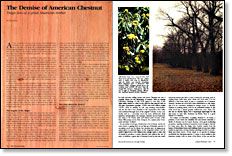The Demise of American Chestnut
Tragic loss of a great American timber
Synopsis: Chestnut was once a a major American timber, but millions of acres of the trees were destroyed by a blight early in the 20th century. writes wood expert Jon Arno. Just a couple generations ago, this wood was everywhere; now, it is gone, almost as if it had never been. Roots aren’t killed off by the blight, but the trees rarely achieve more than shrub size. Wood expert Jon Arno how chestnut rates as timber and expresses his hope for the future. A side article by Rudi Wolf details how Europeans use and prefer chestnut, how seriously the blight has affected trees there, and time-honored ways to use the wood.
At the conclusion of one of my recent wood-identification seminars, a shy and? obviously puzzled young man came up to me with a 2-ft.-long 1×6 of grayish buff-brown wood. Before approaching me, he had fumbled through my set of samples on the table by the podium in search of a match- that would save him from asking the inevitable question, “Do you know what kind of wood this is?”
Because the sample was so beautifully clean and clear, determining its identity stumped me for a minute. But one peek at the endgrain through the hand lens revealed the familiar flame-shaped pore pattern of American chestnut, Castanea dentata. Chestnut was once a major American timber but millions of acres of the trees were destroyed by a blight early in the 20th century. Although my sample set contained American chestnut, there was little mystery as to why this fellow was unable to make the match. My only sample was a remnant of an old barn beam—wormy and streaked with black from the reaction between tannin and steel cut nails—but it was a treasure to me just the same.
As the young man’s shyness subsided, I learned that this magnificent piece of chestnut came from his grandfather’s shop. And since his grandfather had passed away recently, he wasn’t willing to part with this board its value to him went well beyond the rosewood, walnut and money I was prepared to offer in exchange. Later, it occurred to me just how brief each generation’s collective experience is. Only a few decades ago, any schoolboy would have recognized chestnut at a glance. It seemed to be; everywhere: the split rail fence he climbed on the way home, the spice rack on his mother’s kitchen wall, even the chest of drawers from which he plucked his socks in the morning. And now it is gone; it’s almost as if it had never been.
From Fine Woodworking #92
For the full article, download the PDF below:
Fine Woodworking Recommended Products

Stanley Powerlock 16-ft. tape measure

AnchorSeal Log and Lumber End-Grain Sealer

Ridgid R4331 Planer























Log in or create an account to post a comment.
Sign up Log in